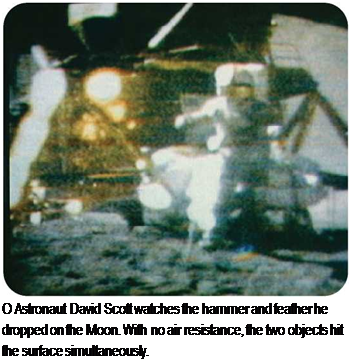Gravity
|
G |
ravity is a force of nature that everyone is familiar with. On Earth, gravity is the force that pulls everything downward. It also keeps the Moon in orbit around Earth and the planets in orbit around the Sun. All flying machines must overcome its pull.
Gravity is a property of matter. It is a force that always pulls, never pushes. Every particle of matter has its own tiny force of gravity, which attracts every other particle of matter.
Sir Isaac Newton (1642-1727) made a scientific study of gravity. He discovered that the force of gravity between two objects depends on their masses and the distance between them. The greater the masses, Newton’s experiments showed, the stronger the force. Newton also found that the farther apart the masses are, the weaker the force. A big mass such as Earth has a strong force of gravity that gets weaker farther away.
Falling
Objects fall to the ground because of gravity. Common sense seems to suggest that heavy objects should fall faster than light objects, but that is not correct. Galileo Galilei (1564-1642) carried out experiments to show that heavy and light objects fall at exactly the same rate. Another way of saying this is that acceleration due to gravity does not depend on mass. If two lumps of clay, one twice as big as the other, are dropped from the same height, they fall
NEWTON’S UNIVERSAL LAW OF GRAVITATION
Isaac Newton’s Universal Law of Gravitation states that the force of gravity between two masses is directly proportional to the product of their masses and inversely proportional to the square of the distance between their centers. The equation that expresses this reads as follows:
F= Gm1m2/d. F is the force of gravity; G is the constant of gravitation; m1 is one mass; m2 is the other mass; d is the distance between the centers of the masses.
_____________________________________________ J
at the same rate and hit the ground at the same instant.
Near Earth’s surface, falling objects accelerate due to gravity at about 32 feet per second per second (10 meters per second per second). This means that the object travels 32 feet per second (10 meters per second) faster every second. Objects falling through the air from a great height eventually stop speeding up because the force of gravity is balanced by air resistance pushing upward. The final speed of a falling object is called its terminal velocity.
In Earth’s gravity, if a feather and a hammer are dropped, the feather takes much longer to fall than the hammer.
 The feather is so light and it has such a big surface area that its fall is slowed by air resistance much more than that of the hammer. In 1971,
The feather is so light and it has such a big surface area that its fall is slowed by air resistance much more than that of the hammer. In 1971,
U. S. astronaut David Scott took a feather and a hammer to the Moon and carried out an experiment. Without any air to slow the feather, it fell as fast as the hammer when Scott dropped them both. The two objects landed on the Moon’s surface at the same time.










